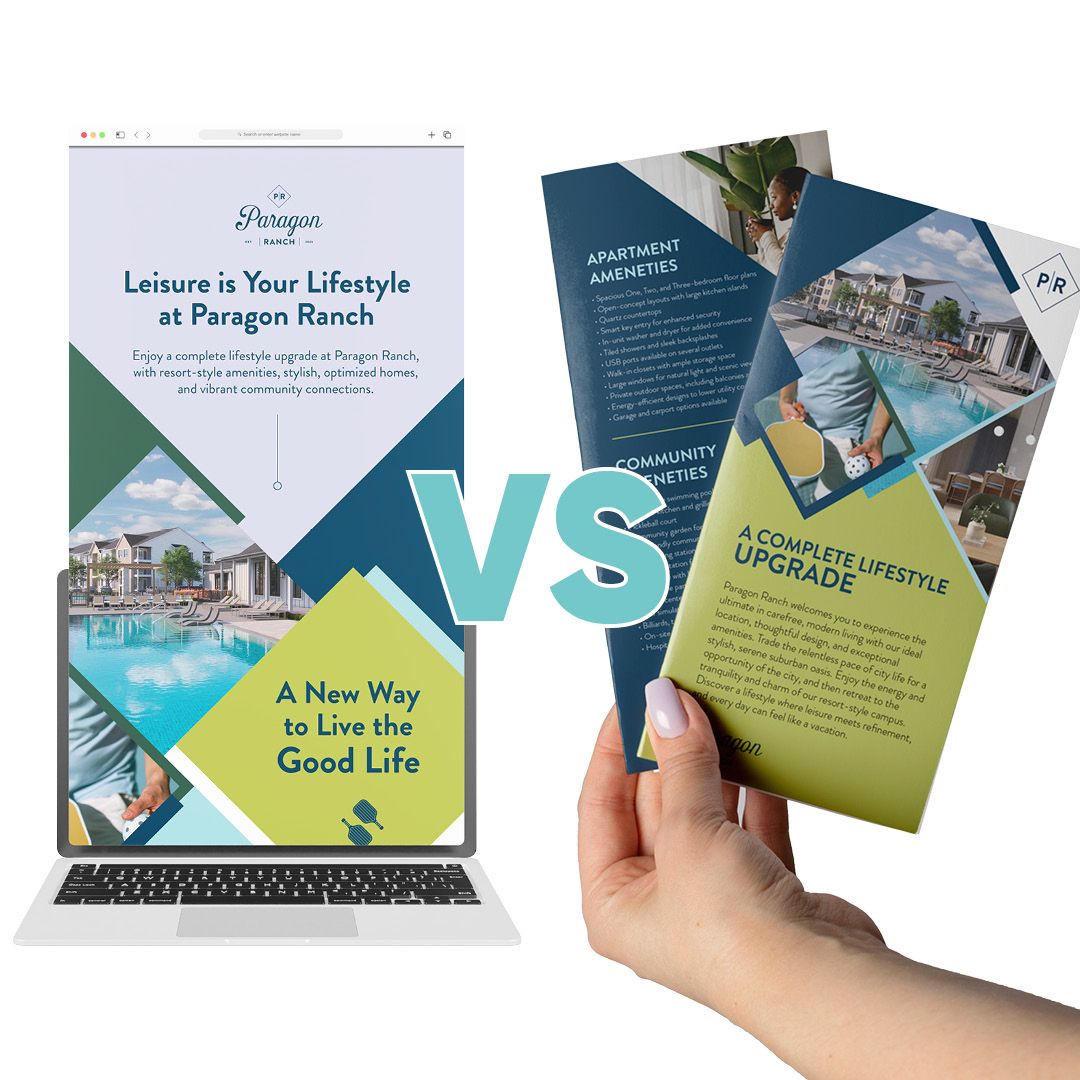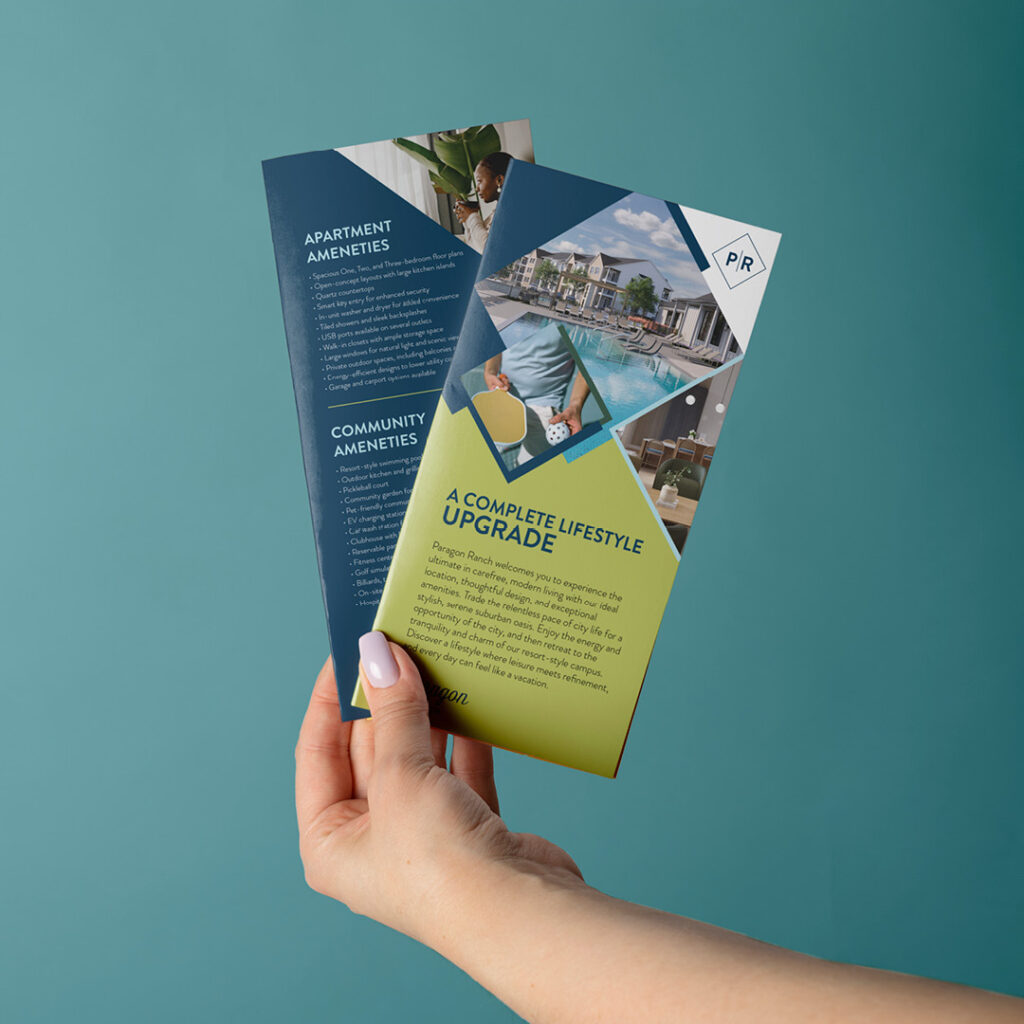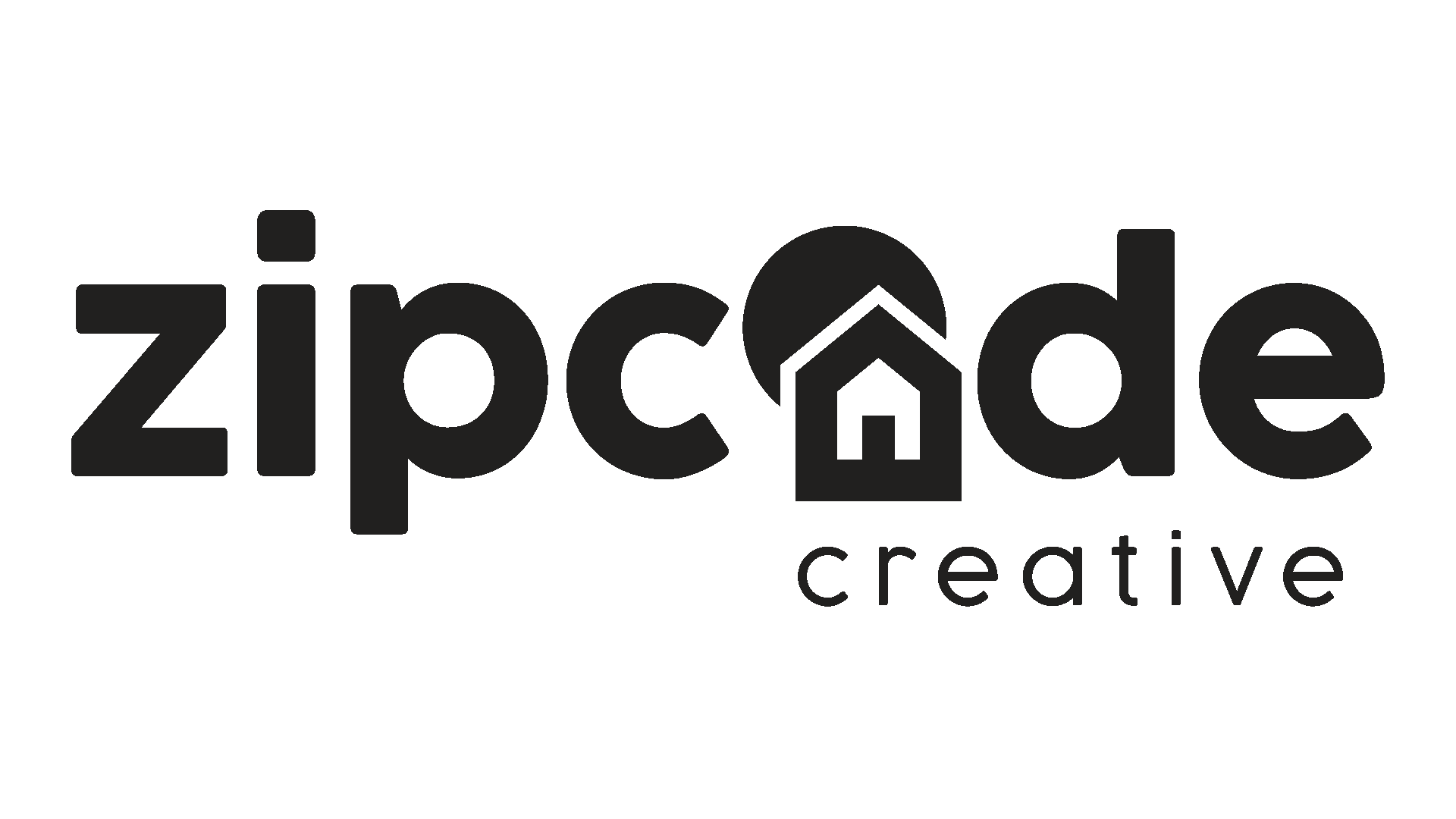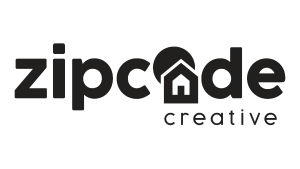
Print vs. Digital Marketing Collateral in Multifamily: Why Brand Strategy Comes First
Stacey Feeney
Brand Strategy Then Format
Brand Supports Format
A strong brand strategy always has to come first. Any decision about marketing collateral format should be made after the branding foundation has been laid. Everything about your brand must be strategic, up to and including the collateral. But the brand supports the format, not the other way around. Digital ads can’t create a brand, just like stationery can’t determine a multifamily company’s values. It’s backwards.
Finetune your brand first. Determine your brand’s positioning (what makes you different) and craft your messaging (verbal identity) and look (visual identity) to truly amplify the collateral you put out. This approach helps property management companies build lasting brand recognition through strategic development across all marketing channels.
The Cost of Skipping Brand Strategy
At Zipcode Creative, we absolutely know and love beautiful design. We also know that it means nothing without excellent brand strategy. Collateral can be as pretty as a picture—but won’t get optimal results if that’s all it is. There’s gotta be a foundation and a structure to it all: What is the story you are telling about who you are as an apartment community? If you sprinkle in some purpose based on your branding work, you’ll probably have a more effective marketing strategy, too. With better branding comes better results.
Know Your Audience, Choose the Format
When developing an apartment community brand, the results will always be better when the ideal resident audience is determined first. The same could be said for your choice of marketing collateral format. If your ideal resident personas are ones that are in the habit of clipping coupons and bringing in direct mail to events, for example, you’d likely want to go for print collateral. How your ideal residents make decisions should be tied to your branding choices as well as your collateral format choices.What kind of research? Demographics, geographics, psychographics and buying behaviors. Same tidbits you’d consider when working through your branding. If done right, look to your brand guidelines to understand your audience for this decision too. Keeping your brand consistent across all collateral ensures residents recognize your community instantly.
U.S. Demographic Preferences
According to research from Pew Research Center, about 96% of adults use the internet. But when we dive deeper into demographics, we can see a better breakdown of who is doing what—and what they prefer based on who they are.
For example, look at age. Gen Z prefers digital. Millennials prefer digital but are open to “tactile experiences.” Gen X likes both. Boomers largely prefer print, but can use simply formatted digital here and there. Getting deeper still, younger demographics prefer YouTube and Instagram for their apartment searches.
Senior Living Complexities
Senior living communities are a more complex consideration. The audience may be a mix of both the prospective resident as well as the family members working to find them a new place to live. So think about how to reach both of those audiences with the collateral—consider using direct mail for the seniors and using targeted ads for their adult children researching options for their aging parents.
In addition to a range of audiences, the search is also multi-faceted: 75% of U.S. consumers begin senior living searches online, with 6,000 searches per hour, yet 70% prefer speaking with someone before deciding.
Formats for Family Involvement
Similar to the complexities of senior living communities’ audiences, you’ll want to determine who will be involved in the decisions for the resident. For student housing, for example, create collateral that will reach the parents as well as the students—so that you can have a multi-pronged marketing approach.
Geographic and Cultural Considerations
Another piece of the puzzle—where your ideal resident lives and the culture they’re surrounded with will impact the collateral that they connect with most. If your audience is multilingual (Spanish and English, for example) you’ll need to consider using both languages on your collateral whether print or digital. If you’re trying to reach a geographic area that has a strong local paper, placing print ads may work well for a community, especially if it’s in an area that hasn’t yet been developed but is just starting to.
Again, each of these choices is relying on branding based on completed homework—who your ideal resident persona or profile is, and then what kind of collateral would best reach them. Understanding local branding strategies can help you connect more authentically with your target audience.


The ROI Reality
When Print Outperforms Digital
According to a study done at Virginia Tech, 82% of the recipients of an alumni campaign remembered a print version of the campaign versus only 49% remembering the online version. Print can sometimes bring about a deeper resonance and retention when pitted against digital versions of the same thing. It’s worth considering what factors are at play before you go all in on print, though. If you’re thinking of going all digital, on the other hand, consider these statistics:
73% of U.S. internet users discover new brands through “offline” channels like TV, print, or radio despite digital dominance.
High-Stakes Housing Choices
Where one lives has a huge impact on quality of life, so most take it very seriously. Trust is a huge factor in marketing. More than 50% of the public across surveyed markets indicate concern over what is real and fake in regards to online news. Trust is at a premium. For example, print ads earn 82% trust from U.S. consumers compared to lower digital trust, while U.S. print sources deliver 112% ROI compared to digital’s 87% ROI.
Cost vs. Efficacy for Different Properties
Find the collateral type that will indicate the brand’s trustworthiness to your audience. Otherwise, ad spend is wasted when no one believes what the brand is saying.
In addition to accounting for different audiences, it’s also worth noting that different properties may also require a different analysis. As mentioned above, senior living and student housing communities will have different approaches, different costs (especially depending on competition for digital ads), and different effectiveness rates for digital over print. Start with an educated guess approach, and then adjust as needed.
To track efficacy, use special codes or copy that says “Mention this postcard when calling” to better find the best part of your buyer’s journey. This integration strategy can increase campaign effectiveness by up to 400% when print and digital work together.
Format Decisions
If your brand foundation’s been laid, you can move forward with marketing collateral. But where to use print or digital? And when? And how much?
Assessment Questions
Ask these questions to get at which format will work best for the brand:
- How personalized do you want this marketing to be?
- Do your users value tangibility?
- What is the reach you want to achieve with this message?
- What’s your budget, and what do you need to accomplish with the money you spend to make it “worth it”?
- Do you want to A/B test during the campaign (rather than run the campaign again in print to compare)?
- Does your audience want an interactive experience rather than something static?
Integration Strategies
Usually, integrating print and digital is going to work best for any brand, but depending on the goal of any campaign, you’ll know which format could work better. If you’re hoping for more online tours to be booked through the website, use digital ads—it’s the fastest route from one click to the website. If you’re hoping to bring more people in to take a physical tour, use printed mailers with an offer that can be redeemed exclusively in person.
Balance both, based on your audience’s demographics, as well as the budget you have to spend and the ROI you need to show. Having the right marketing collateral essentials ensures your brand message stays consistent across both print and digital formats.
Marketing is never one-and-done. As long as you have your branding set up properly and your research solidified on your ideal resident—along with their decision timeline and the pain points of their apartment or home search—your print collateral and digital collateral can work together to capture (and convince) the segment you want.
Ready to create marketing collateral that actually converts? Whether you need print brochures, digital ads, or a complete brand strategy, we design everything using your brand guidelines to ensure consistency across every touchpoint. Let’s talk about your next project.


